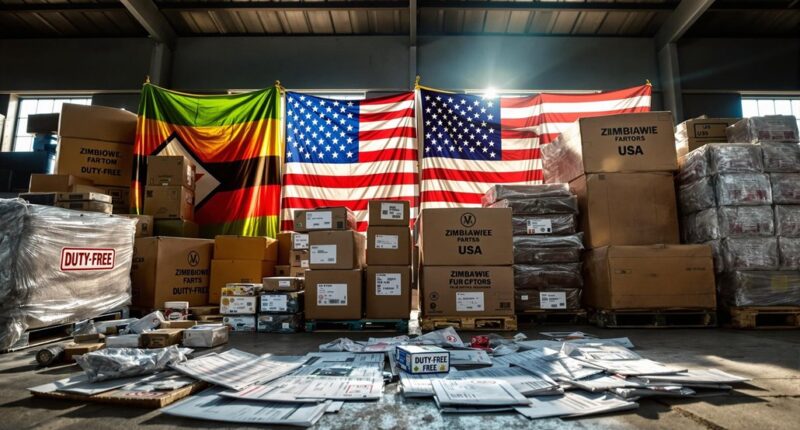Zimbabwe has eliminated all import tariffs on US goods, according to the Ministry of Finance and Economic Development. The policy aims to make American products more affordable for Zimbabweans and boost trade relations between the countries. Previous import duties ranged from 10% to 40%. While consumers can expect price reductions on popular American brands soon, local manufacturers worry about increased competition. The full economic impact will become clear in the coming months.
Zimbabwe has eliminated all import tariffs on goods coming from the United States. The move, announced yesterday by Zimbabwe’s Ministry of Finance and Economic Development, aims to boost trade relations between the two nations. Officials say this notable policy change will make American products more affordable for Zimbabwean consumers and businesses.
The tariff suspension applies to all US goods entering Zimbabwe, from agricultural products and machinery to consumer electronics and vehicles. Previously, these items faced import duties ranging from 10% to 40%, making many American products too expensive for the average Zimbabwean consumer.
Zimbabwe’s sweeping tariff elimination covers everything from farm equipment to smartphones, making once-prohibitively expensive American goods accessible to local consumers.
“This is an important step toward strengthening our economic ties with the United States,” said a government spokesperson. “By removing these trade barriers, we’re creating new opportunities for businesses in both countries.”
The decision comes as part of Zimbabwe’s broader strategy to expand bilateral trade with major global economies. Economic analysts suggest the policy could considerably increase the volume of US exports to Zimbabwe, which has remained relatively low compared to trade with countries like China and South Africa.
For Zimbabwean businesses that rely on American equipment and supplies, the tariff elimination represents a potential lifeline. Manufacturing companies, in particular, are expected to benefit from cheaper access to US technology and machinery parts.
US officials have welcomed the move, noting that it could lead to reciprocal trade benefits for Zimbabwean exporters in the future. The US Embassy in Harare issued a statement calling the decision “a positive development in our commercial relationship.”
Consumers in Zimbabwe’s major cities are likely to see price reductions on popular American brands within weeks. This decision comes as a stark reversal from the previous trade situation where the US claimed Zimbabwe imposed a 35% tariff on American goods. Retail experts predict that sectors such as electronics, automotive parts, and certain food products will see the most immediate impact.
However, some local manufacturers have expressed concerns about increased competition from cheaper American imports. Industry representatives have called for support measures to help domestic producers adapt to the new trade environment.
The government has assured local businesses that the policy is designed to complement, not replace, efforts to strengthen Zimbabwe’s manufacturing sector. Officials point to potential knowledge transfer and partnership opportunities that could emerge from increased US business presence in the country.
The tariff elimination takes effect immediately, though full implementation across all ports of entry may take several weeks. President Mnangagwa has emphasized that the move is intended to construct a positive relationship with the United States while promoting Zimbabwean exports. Customs officials are receiving training on the new procedures to guarantee smooth processing of US imports.
Economists predict that the full impact of this policy change will become apparent within the next six to twelve months as supply chains adjust and new business relationships develop between companies in both nations.
Conclusion
Zimbabwe’s decision to cut US import tariffs marks a significant step in easing trade tensions between the two nations. This move should boost trade flow and potentially lower prices for Zimbabwe’s consumers. While challenges remain in the bilateral relationship, both countries’ trade officials are optimistic that this development will lead to improved economic cooperation in the months ahead.








